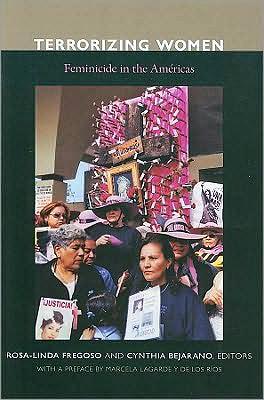Terrorizing Women: Feminicide in the Américas

Terrorizing Women is a collection of papers written on the subject of feminicidio (feminicide), a term Marcela Lagarde y de los Rios used to identify the genocide of women when conditions exist “that allow for violent attempts against the integrity, health, liberties, and lives of girls and women.” As such, feminicide is an extreme form of gendered violence that involves the violation of women's and girls' human rights, is a threat to their safety, endangers their lives, and culminates in their murder.
Ciudad Juarez, probably the world’s best known city with an unimaginable rate of feminicide, has seen the murder of more than 600 women and girls and the disappearance of at least 1,000 more in time frame spanning less than two decades. Although there are many factors that allow for such a high rate of feminicide to continue undeterred in a border space such as Cuidad Juarez, feminicide is a widespread occurrence beyond Mexico, reaching into all of the Americas, with many different roots, but with similar factors underlying the opportunity for, and the impunity with which such violations of human rights continue to occur.
Terrorizing Women is divided into three parts, each part starting with a personal testimony of Mexican and Guatemalan women directly affected by an act of feminicide. These testimonies offer a glimpse into the terrifying and painful experiences the survivors of victims of feminicide have to endure.
“Localizing Feminicide” focuses on the location, or territories, where feminicides are rampant—including countries such as Mexico, Costa Rica and Guatemala and cities such as Ciudad Juarez and Mar del Plata—and the social and historical reasons behind the feminicides. “Transnationalizing Justice” exposes some of the reasons into why feminicide has been allowed to continue, with no end in sight, by exploring the roles of governments, NGOs, economics, accountability and justice systems with a focus on Ciudad Juarez. Part Two concludes with a photo essay, “Images from the Justice Movement in Chihuahua, Mexico.” “New Citizenship Practices” explores the role of poor migrant women’s citizenship and human rights in the border space; the role and limitations of the term feminicidio; the uses of the term in Peru, Guatemala, and Mexico; the paradox of the Ni Una Más (Not One More) campaign of Northern Mexico; and the symbolic leaders of the movement, the Mujeres de Negro (Women Dressed in Black).
Terrorizing Women is an eye-opening examination of the staggering numbers of feminicides occurring near the border between the U.S. and Mexico, and throughout Latin America, an exploration into the motivation behind the killings and the reasons for the impunity received by criminals, and an insight into the strength, courage and determination of the surviving relatives of those who disappeared, to continue the fight for justice.